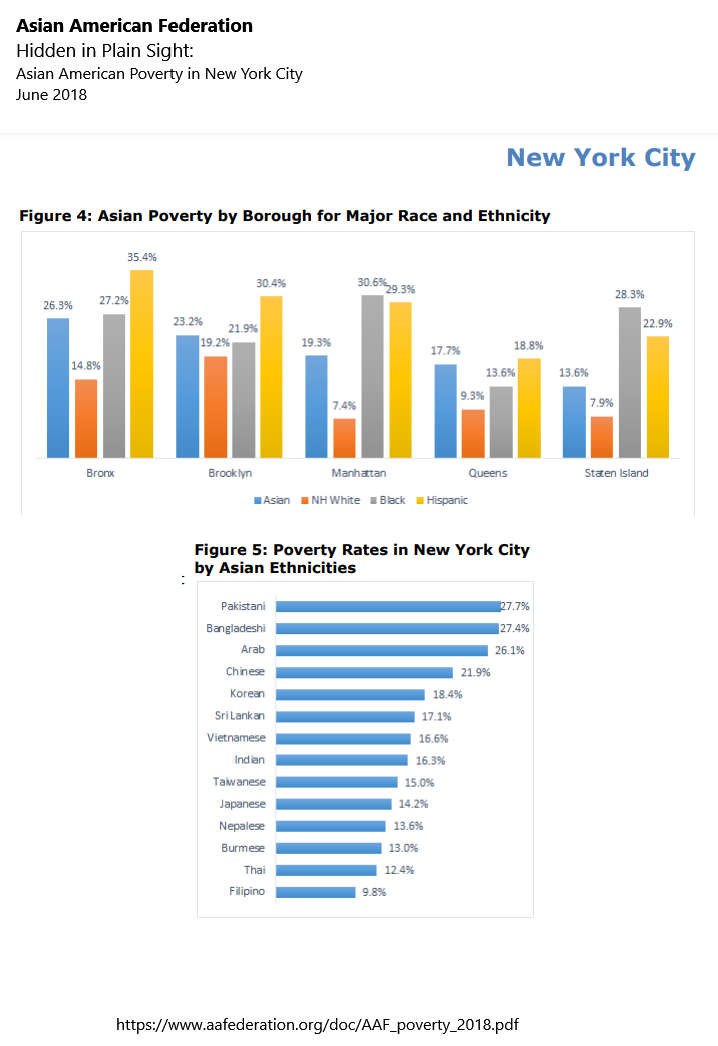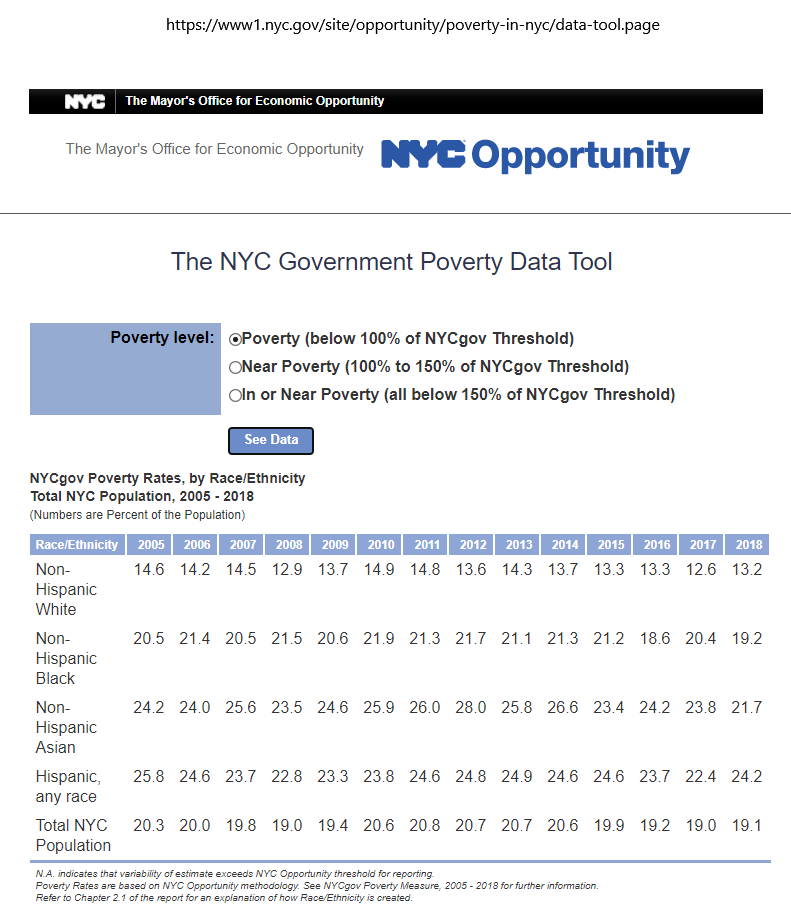.
"1 in 4 Asian Americans in New York City live in poverty"
Asian American New Yorkers experienced highest surge in unemployment during pandemic
NBC Oct. 21, 2020,
https://www.nbcnews.com/news/asian-a...demic-n1243894
(last paragraph)
.
_________________________________________________
 https://www.nysenate.gov/sites/defau...ration_aaf.pdf
https://www.nysenate.gov/sites/defau...ration_aaf.pdf
(many more charts at link)
Asian American Federation
Hidden in Plain Sight:
Asian American Poverty in New York City
June 2018
COVID-19’s strain on our community is set against the backdrop of some disturbing statistics.
Overall, 14.1% of Asians in the State live in poverty, compared to a statewide poverty rate of
13.6%. Among seniors, 1 in 5 Asian New Yorkers lived in poverty compared to just over 1 in 10 of
all seniors in the state.
Key findings include:
Upstate New York
In Upstate New York, Asians living in poverty more than doubled from less than
19,000 in 2000 to close to 43,000 in 2016.
The Asian poverty rate rose from 19.7 percent in 2000 to 23.1 percent in 2016.
Asian poverty in the upstate region is largely concentrated in or near cities such as
Albany, Binghamton, Buffalo, Ithaca, Rochester, Rome, Syracuse, and Utica.
Asian population growth was driven in part by a wave of refugees resettled from
Bhutan and Myanmar, countries that have not traditionally sent immigrants to the
United States in large numbers.
New York City
In New York City, the number of Asians living in poverty grew by 44 percent, from
170,000 in 2000 to more than 245,000 in 2016.
Poverty rates are higher for Asian immigrants, both citizens and non-citizens, as
Asian immigrants tend to be more recent arrivals. One in four Asian immigrants
arrived to the United States less than 10 years ago, compared to 18 percent
of nonAsian immigrants.
Of immigrants in poverty, 70 percent of Asian immigrants and 59 percent
of nonAsian immigrants had limited English proficiency (LEP).
Asian child poverty rates increased from 2000 to 2016 by 1.4 percentage points.
Among children in poverty, 43 percent of Asian children lived in a linguistically
isolated household, compared to 19 percent of non-Asian children and 27 percent of
Hispanic children.
While 51 percent of non-Asian children in poverty were living with at least one
immigrant parent, 96 percent of Asian children in poverty were living with at least one
immigrant parent.
The poverty rate for Asian seniors rose from 23.5 percent in 2000 to 24.8 percent in
2016.
For seniors living in poverty, LEP rates were 83 percent for Asians, compared to 24
percent for non-Asians.
English proficiency opened up economic opportunities for Asian workers. For Asian
workers living in poverty, 63 percent had LEP, while for Asian workers living at or
above the poverty threshold, only 40 percent had LEP.
Two of the major occupational categories that Asian workers in poverty held were nail
salon work and food delivery work, both of which have seen increased regulatory
scrutiny at the state and local level.
The restaurant and food service industry was a vital source of employment for Asian
workers living in poverty, employing 21 percent of those workers. Among non-Asian
workers living in poverty, only 10 percent were employed in this industry.
Access to affordable housing and health insurance remain a challenge for Asians in
poverty. Nine in ten Asian households in poverty were lacking affordable housing. One
in four working-age Asians in poverty were uninsured.
https://www.nysenate.gov/sites/defau...ration_aaf.pdf
__________________________________________________ _________________________
Roosevelt House Public Policy Institute or Hunter College.
Student Forum Posted on December 9, 2019
Researching Asian Poverty in New York
Sabrina Song
There is a lack of disaggregated data on Asian poverty in New York City. Asians in poverty are hidden behind the veil of the “model minority” stereotype, which masks the fact that even within the broader racial category there are ethnic groups that have drastically different levels of poverty. According to The New York Times, Asians are the fastest growing racial/ethnic population New York City, having doubled in size since 2000 and nearing 15% of the population.
Yet, Asians are underrepresented in data, and many studies describe the lack of understanding that stems from this. According to the 2019 New York City NYC Government Poverty Measure, 23.8% of Asians are in poverty by municipal standards. This is the highest rate of all racial/ethnic groupings, which include White, Black, and Hispanic/Any. Due to a mistaken belief that Asians do not need financial aid (a consequence of the image of the “model minority,” or the idea that Asians are hardworking overachievers who are closest to the idealized White success), both the government and Asians themselves overlook the poor Asians who need lifelines. The Asian American Federation reports that in 2014, the Department of Social Services provided an average of $600,000 to Asian American community-based organizations (CBOs), while the average contract dollar amount they distributed to other affinity groups was $1.4 million. Meanwhile, Asians had the highest poverty rates in New York City NYC at the time. What further complicates the issue is that even within the broader category of “Asian,” disparities arise when examining specific ethnic groups.
For example, t
he highest poverty rates among Asians in New York City by ethnic group are Pakistani (28%), Bangladeshi (27%), Arab (26%), and Chinese (22%). The diversity within Asian American backgrounds makes it difficult for general policies and programs to assist those that are not well-represented or specifically addressed.
Researching Asian Poverty in New York - Roosevelt House Public Policy Institute at Hunter College
__________________________________________________ ___
 https://www1.nyc.gov/site/opportunit...data-tool.page
https://www1.nyc.gov/site/opportunit...data-tool.page

 Please register to participate in our discussions with 2 million other members - it's free and quick! Some forums can only be seen by registered members. After you create your account, you'll be able to customize options and access all our 15,000 new posts/day with fewer ads.
Please register to participate in our discussions with 2 million other members - it's free and quick! Some forums can only be seen by registered members. After you create your account, you'll be able to customize options and access all our 15,000 new posts/day with fewer ads.